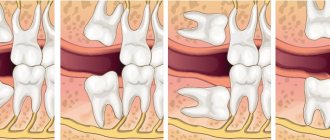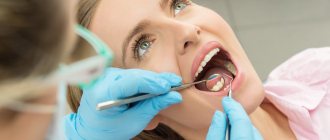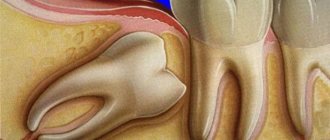For most people, the growth of wisdom teeth is accompanied not only by gum cutting and discomfort, but also by quite severe pain that makes it difficult to eat, concentrate on any task, and even sleep.
If the wisdom tooth grows and does not cause significant discomfort, no medical action may be taken. As a rule, the discomfort goes away after 1-2 weeks, but in order to avoid the manifestation of other problems, it is worth undergoing an examination at a dental clinic. However, if the gums from the wisdom tooth become inflamed, the local and general temperature rises, and specific aching pain is felt, immediately contact your dentist, he will conduct an examination and take the necessary measures to eliminate the problem.
Symptoms of wisdom tooth growth
During the period when a wisdom tooth comes in, a number of specific symptoms can be observed, by which it can be determined that the discomfort comes specifically from the eights:
- Discomfortable sensations in the tooth area, in some cases – gum thickening;
- Feeling of swelling in the gums;
- Increased local temperature, painful swelling;
- In the molar area, soft tissues (gums) become inflamed;
- Difficulty opening the mouth and swallowing. When opened wide, a sharp, aching pain is felt;
- There is a desire to chew any hard food or objects. After such chewing, the pain increases significantly;
- General increase in body temperature, general malaise and headaches.
Depending on the nature of growth, pain in wisdom teeth and specific symptoms can vary significantly. Regardless of how long a wisdom tooth grows - one or two weeks, it will cause certain sensations, and in case of complex or pathological growth - acute pain with inflammation of the gums.
An increase in general body temperature and swelling of the cheek indicates a severe course, as well as the possible development of pericoronitis - a complex disease of the oral cavity with a number of consequences.
Duration of figure eight eruption
The process is long and painful. Since they erupt in adulthood, the bone tissue is formed, it is harder for the tooth to pass through the bone. If there is a place on the jaw, it appears painlessly. If it is not enough, the person faces difficulties. Let's look at the signs that indicate problems with wisdom teeth. When a wisdom tooth breaks through the bone, the symptoms are as follows:
- Painful sensations and swelling. During chewing, unpleasant sensations arise.
- When the tooth does not cut through the gum, it lifts it and forms a hood. When food and bacteria enter, inflammation develops.
- Sore throat often occurs as a result of inflammation spreading to nearby tissues.
- Unpleasant sensations in the ear, including otitis media or otalgia.
- Along with eruption, the lymph nodes become inflamed and lymphadenitis occurs.
- It happens that the figure eight, the eruption of which is just beginning on the gum, is partially located in the mandibular canal.
- There is a feeling of stiffness that extends over half of the head.
- If the dentition becomes crooked, there is no room left for the eighth molar. It will not fall out, but will move the formed row and make room for itself.
The main causes of pain
Painful symptoms from wisdom teeth are caused by the anatomical features of the upper and lower jaw, which are already fully formed in a person at the age of 17-25.
As the figure eight begins to grow, it puts pressure on neighboring teeth, bone and soft tissue. The growth process can last for months and even years, so pain manifestations are temporary, periodically fading and exacerbating.
The pain of tooth 8 can be provoked not only by its growth or anatomically incorrect position, but also by the presence of various pathologies, for example, caries, pulpitis, periodontitis or a wide range of infectious diseases. Note! The lack of timely professional help can provoke a worsening of the situation, which will result in the need to remove the diseased tooth and treat complications.
Molar growth process
With proper growth, figure eight teeth do not cause any particular trouble to the patient. The physiological process ends with the vertical position of the extreme molar, which eliminates changes in bite, caries and the formation of a hood.
The patient may complain only of slight redness and thickening of the gums, mild pain, which can last from several days to a month.
During the eruption of extreme molars, some pathological phenomena may occur.
Most often, these include tooth deviations from vertical growth:
- The process of tilting the molar forward towards the seven is called medial tilt.
The process of tilting the molar forward towards the seven is called medial tilt. It can provoke the onset of caries in a neighboring tooth, the reason for this is constant pressure on the enamel and the accumulation of microorganisms in the gap formed between them.
- With a distal tilt , when the figure eight grows backward, its urgent removal is necessary.
- The eruption of a molar towards the cheek is accompanied by damage to its mucous membrane. The buccal tilt of the tooth can provoke malignant tumors at the site of damage.
- During horizontal and linguistic growth, compression of the roots of sevens , sixes and fives occurs. This causes an inflammatory process that requires immediate removal.
How to relieve pain if a wisdom tooth grows and your gums hurt.
The growth of wisdom teeth is not painless for every person, so most people need to know what to do in case of inflammation of the gums around the wisdom tooth and acute aching pain.
If there is inflammation, pain, or if the cheek is swollen near the wisdom tooth, you should contact your dentist, he will conduct an examination and take the necessary measures to eliminate symptomatic manifestations.
If the pain begins in the evening or it is not possible to quickly contact a specialized specialist, doctors recommend several ways to reduce pain:
- Rinse the growth with calendula tincture after eating - this will reduce the intensity of the inflammatory process and also reduce pain;
- Rinse your mouth with a solution of baking soda in water, at the rate of 1 teaspoon of soda per 1 glass of water (200 grams) - soda calms inflammation and also reduces pain;
- To rinse the mouth, you can use decoctions of chamomile, oak bark, chicory root, as well as sage tincture and propolis;
- Anti-inflammatory, painkillers and antibacterial drugs - use according to the instructions. They help reduce pain, reduce swelling, and also eliminate the negative bacterial influence at the site of tooth eruption.
In case of acute unbearable pain, as well as the absence of the above remedies, you can use cold water to reduce pain: take a glass of cool water, put a small amount in your mouth and hold it in the area where the wisdom tooth is erupting - this can quickly reduce the level of pain. However, this method has one negative feature - the pain intensifies almost immediately after stopping holding cool water at the site of gum inflammation, for example, near the hood of a wisdom tooth.
How long do eights grow?
The period for the last element to appear on the surface ranges from 4 weeks to 10 years. On average, patients may experience discomfort from the eruption of wisdom teeth for up to 1.5 months. After the crown appears, the discomfort subsides. Then there is a pre-formation stage, which can take up to 5–7 years. An element is considered formed after its roots appear, which can number from 3 to 5.
Only a doctor can decide whether to remove the problematic element or not. The main indications for surgical intervention are chronic pericoronitis, compression of the roots of an adjacent tooth by the figure eight, damage to the soft tissue of the gums on the crown of a molar. If there are no problems when cutting through the unit, then experts leave the eights untouched. These teeth are as important as all other elements, despite the fact that they do not take part in the digestion of food.
Squeezing an adjacent element with a figure eight
The last molars prevent the remaining teeth from moving to the side and prevent various malocclusions. When prosthetizing sevens, the last molars can be considered as a support for orthodontic structures. For this reason, doctors try to preserve the element even if it is damaged by caries.
Where can I get dental care in Orenburg?
If your gums hurt where your wisdom teeth are, you can get qualified dental care in two places: public and private dental clinics. During the appointment, the dentist must:
- Conduct a preliminary examination of the oral cavity, determine the exact cause of the development of painful symptoms;
- If necessary, refer the patient for an x-ray - this procedure is often necessary in the presence of impacted wisdom teeth (completely or partially covered by gum), as well as in the case of surgical removal;
- Take the necessary measures to reduce or eliminate pain and swelling, as well as prevent further aggravation of the situation;
- If necessary, refer to a dental surgeon to remove third molars;
- Provide recommendations for further dental and oral care.
Do your gums hurt and you have symptoms of wisdom tooth growth? Seek qualified help from specialized specialists!
When do the extreme molars erupt? How long does the process take?
The appearance of third molars depends on the characteristics of the human body. According to statistics, the eighth teeth grow between the ages of 17 and 25 years. The absence of signs of growth of extreme molars should alert a person and cause him to contact specialists.
After many X-ray studies, it became known that third molars begin to form at the age of seven.
The growth and duration of the process, in turn, depend on hereditary factors, the general condition of the body and the structural features of the jaw.
The physiological process takes from several days to a month, and sometimes even several years. Some people erupt all their teeth at the same time, while others by the age of forty have only one or no outer molars at all.
When pain is normal
When a tooth is cutting and your gums hurt, this condition can be considered normal. The sensations should not be too sharp; they are rather nagging and dull, monotonous, aching.
Do not forget that the tooth began to emerge in adulthood; it did not have a milk predecessor that would have left behind a “beaten path.” The bone tissue of an adult has finally formed, the gums are dense and thick, and it is natural that the third molar injures and damages tissue and touches nerve endings when it passes through them.
Difficult removal
Such an operation is considered difficult when the upper molar has to be extracted in parts with an incision in the gum and sawing of the crown. The procedure occurs in stages:
- X-ray or CT scan;
- gum pain relief. In case of a complex clinical picture, it is possible to perform the operation under general anesthesia;
- dissection of the gum is performed to open access to the crown;
- the surgeon pulls out the molar. It is often necessary to first remove the crown with a drill to ensure free access to the roots;
- the hole is carefully checked for the presence or absence of bone fragments.
In cases of bone resection, the hole is filled with special bone chips, which subsequently form new bone tissue.
Since the operation is complex, the rehabilitation period is longer and can last for several weeks.
Easy removal
When nothing prevents you from removing the tooth from the socket and cutting the gums with a scalpel is not required, then such removal is considered simple. The procedure is carried out in the following order:
- the doctor orders an x-ray or recommends a CT scan;
- the problem area is numbed with local anesthetics;
- Using forceps, the surgeon first rocks the tooth and then pulls it out of the socket.
After the tooth is removed, the hole is treated with an antiseptic solution, after which a sterile swab is applied to it. If necessary, the wound is sutured. The entire procedure lasts about 10 minutes.
How to accelerate growth?
It is impossible to speed up the process of teething: it depends on the characteristics of the whole organism and the structure of the jaw, the location and direction of the “eights”. In this case, only the symptoms can be eliminated.
But it is important to remember: heating the gum or cheek is strictly prohibited!
This provokes an acceleration of the inflammation process and the rapid spread of infection to the nearest teeth.
It is also not recommended to rinse the mouth with hot decoctions. It is best to use a decoction of salt and soda before going to the dentist: it has disinfecting properties, will remove food particles and reduce pain.
Under no circumstances should you cut the gum tissue yourself using sharp objects. This can lead to severe bleeding and infection.
Step-by-step process for wisdom tooth removal
What complications may arise during horizontal eruption?
- wisdom teeth can contribute to the displacement and tilt of “sevens”, “fives” and “fours” towards the center of the jaw: in this situation they act almost on the principle of braces. True, the effect will not be positive, but negative, because crowding will appear in the frontal zone, and the bite will be disturbed,
- they can destroy the adjacent seventh tooth, its crown and even the bone tissue around it.
What to do if the third molar is cut during pregnancy
If a wisdom tooth is cut incorrectly or irregularly during pregnancy, then the first thing a woman needs to do is see a dentist. This process requires close monitoring. The expectant mother cannot undergo surgical manipulations, so the main task is to prevent acute inflammation, which will make it necessary to take drastic measures - to remove the third molar.
To relieve symptoms, a woman can be prescribed antiseptics (for example, Miramistin), rinsing with herbal decoctions, as well as painkillers that are acceptable for the trimester of pregnancy in which she is.
Read about when dental intervention is permissible during pregnancy in the article on the website.
If there is an emergency need to remove a tooth, the doctor must assess all possible risks and conduct a thorough assessment of the health of the expectant mother and child.
When are third molars removed?
There are a number of reasons why removing “eights” is necessary:
- incorrect direction of the tooth during growth;
- lack of space;
- change in the position of the teeth (crowding);
- strong pressure on the seventh molar;
- process of purulent inflammation;
- crown destroyed by caries.
In some cases, your doctor may advise you not to pull out your molars.
For example, if a patient undergoes dental prosthetics, during eruption they will take the correct position, and the canals are clearly visible for further treatment.
What measures will help with pericoronitis?
If there is no active inflammatory process, then at home you can perform antiseptic treatment of the oral cavity using Chlorhexidine or Miramistin. To eliminate the pain symptom, doctors advise using drugs from the group of non-steroidal anti-inflammatory drugs with ibuprofen - Ibuprofen, Paracetamol, Diclofenac. Local applications of Cholisal, Kamistad, and Kalgel gels, which have an anesthetic and anti-inflammatory effect, will also help.
On a note! Rinse with antiseptics at least twice a day - always in the morning after breakfast and oral hygiene, and in the evening after brushing. The duration of one procedure should be at least 1 minute.
If the inflammation is acute and complicated by the accumulation of pus, then you need to consult a doctor who will excise the hood hanging over the figure eight. Next, the scheme is the same - anti-inflammatory drugs, antiseptics and gels at home.
Provided that there is not enough space for the third molar to erupt on the jaw, excision of the hood will only give a temporary effect, and the inflammation will recur, so the doctor may decide to remove it.
Where did teeth get their name?
One of the theories, so to speak, “folk”, is associated with late periods of eruption. Allegedly, after 20 years of life, a person has already gained some experience and become wiser.
The scientific or “Darwinian” theory says that this happened during evolution. Human ancestors, monkeys, used their teeth not only for chewing and grinding food, but also for turning improvised devices and tools and participating in fights, so they lost them in their youth. And the third molars appeared late precisely so that the monkeys, already in old age, could at least somehow process food.
Possible complications
Inflamed gums cause pain when chewing or swallowing, poor health and fever.
Pericoronitis is one of the serious complications that can occur during the eruption of third molars.
The disease is characterized by an inflammatory process that affects the tissue around the tooth.
Inflamed gums cause pain when chewing or swallowing, poor health and fever.
A characteristic feature of pericoronitis is the abundant proliferation of bacteria under the hood.
Around the third day, the disease becomes purulent. The patient complains of severe toothaches and pain radiating to the ear and temples, painful opening of the mouth.
The presence of pus under the formed hood causes intoxication of the body, which is manifested by high temperature. The patient has severe facial asymmetry on the side of the diseased tooth, pale face and inflammation of the lymph nodes.
Due to the proximity of the figure eight to the second molar, a small gap is formed in which food debris accumulates. The proliferation of bacteria in most cases leads to the appearance of caries.
A tooth that has already come out is considered the most convenient place for bacteria to multiply: its inconvenient location makes them difficult to clean. After some time, the gums become inflamed and swollen. Flux occurs with fever, severe pain and a swollen cheek.
When the upper tooth erupts, the trigeminal nerve may become inflamed, which is manifested by involuntary contraction of the facial muscles and sharp pain. With late therapy, facial paralysis may occur.
An abscess is a purulent disease that causes an unpleasant odor from the mouth, severe throbbing pain, a constant bitter taste and swelling.











